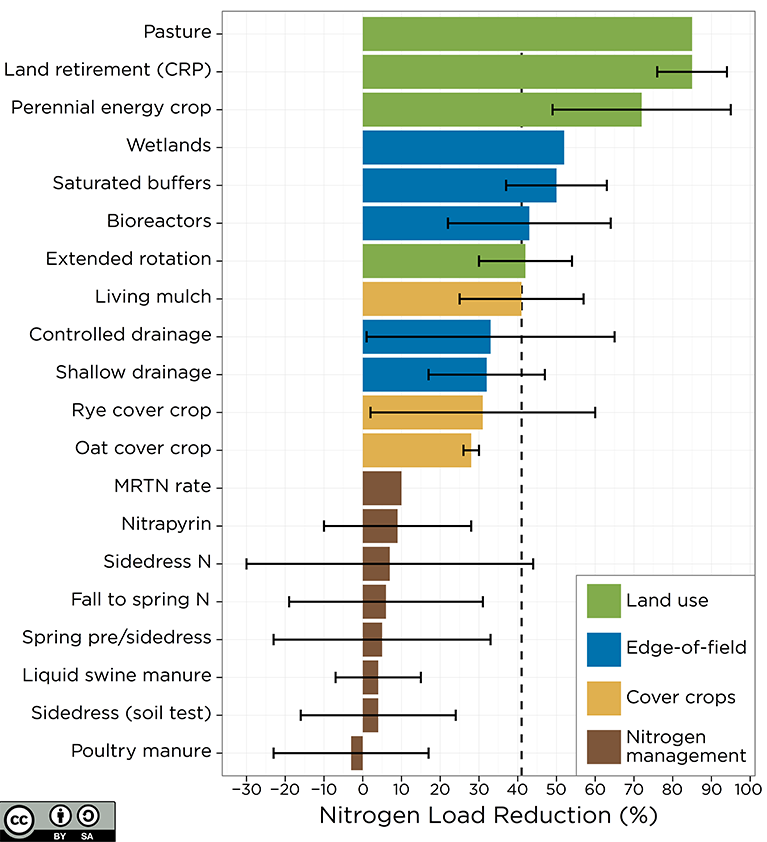Agricultural Runoff
Runoff from tilled fields can carry chemical fertilizers, pesticides, and soil to nearby trout streams via overland flow and groundwater. As large a problem is nitrogen fertilizer leaching downward past plant roots. Nitrogen, in the form of nitrates, moves through the soil, and ends up in groundwater or surface water bodies. This can occur when fertilizer is applied to fields, but not entirely taken up from plants. Instead, it is washed away by rain or irrigation, percolating through the soil to groundwater or nearby streams. Practices that retain or slow runoff and increase infiltration, reduce fertilizer and pesticide use, and reduce erosion are beneficial to maintaining the health of our trout streams.
Both manure management and continuous living crops can play important roles in reducing nitrates and improving overall nutrient management in agriculture.
Research tells us, however, that practices focused on keeping plants in the ground- whether through cover crops, buffer strips, or restoring and retaining wetlands-are most effective at reducing nitrogen loads that wash or leach into our streams.
The risk of water pollution is especially high in the “karst” geology which makes southeast Minnesota’s Driftless area such a phenomenal trout mecca. This karst region has porous bedrock close to the surface which creates the large, cold springs which in turn produce the amazing spring creeks concentrated here. Unfortunately, the porous bedrock also allows contaminants on the surface to easily reach this groundwater and our beloved trout streams.
Nitrogen
The nitrogen cycle is complex and results in various nitrogenous compounds, including nitrate and ammonia. Nitrate in the predominant form of nitrogen in surface waters in the karst region and in concentrations reported, have negative effects on aquatic life (i.e., above 4 mg/liter). The ammonia in fertilizer (ammonium nitrate) is more toxic than nitrate. Elevated ammonia levels have been detected in some of the recent fish kills (e.g., Garvin Brook in 2019), indicating manure applications as the cause of the fish kill. Nitrate contamination to our trout streams is a particular issue of concern. The Minnesota Pollution Control Agency’s monitoring of surface waters shows elevated nitrate levels, particularly in Minnesota’s southeastern corner. Very high nitrate levels in groundwater and trout streams harm both humans and aquatic ecosystems. You can read more about nitrates and how MNTU is taking action here and more about fish kills here.
Neonicotonoids
Pesticide contamination in our streams is another major problem, especially in the form of neonicotoids. Aquatic insects provide the essential food which supports trout fisheries. The concentrations of two neonics – chemicals designed to kill insects indiscriminately – are routinely found in Minnesota streams at levels harmful and lethal to aquatic insects. The MDA has determined that seeds coated with neonics are the leading source of these highly toxic, persistent neonics in Minnesota waters. Protecting and improving our trout fisheries requires we act to protect and improve the aquatic insect populations that trout depend on. You can read more about neonics and how MNTU is taking action here.
What’s next?
Stay tuned for opportunities to support neonic related bills in the 2025 legislative session.
Sign up for our regular action alerts to get involved!
Resources
Figure 1:Nitrogen Load Reduction, Data from the INRS (IDALS, IDNR, ISU CALS). Images courtesy of Iowa Soybean Association.

